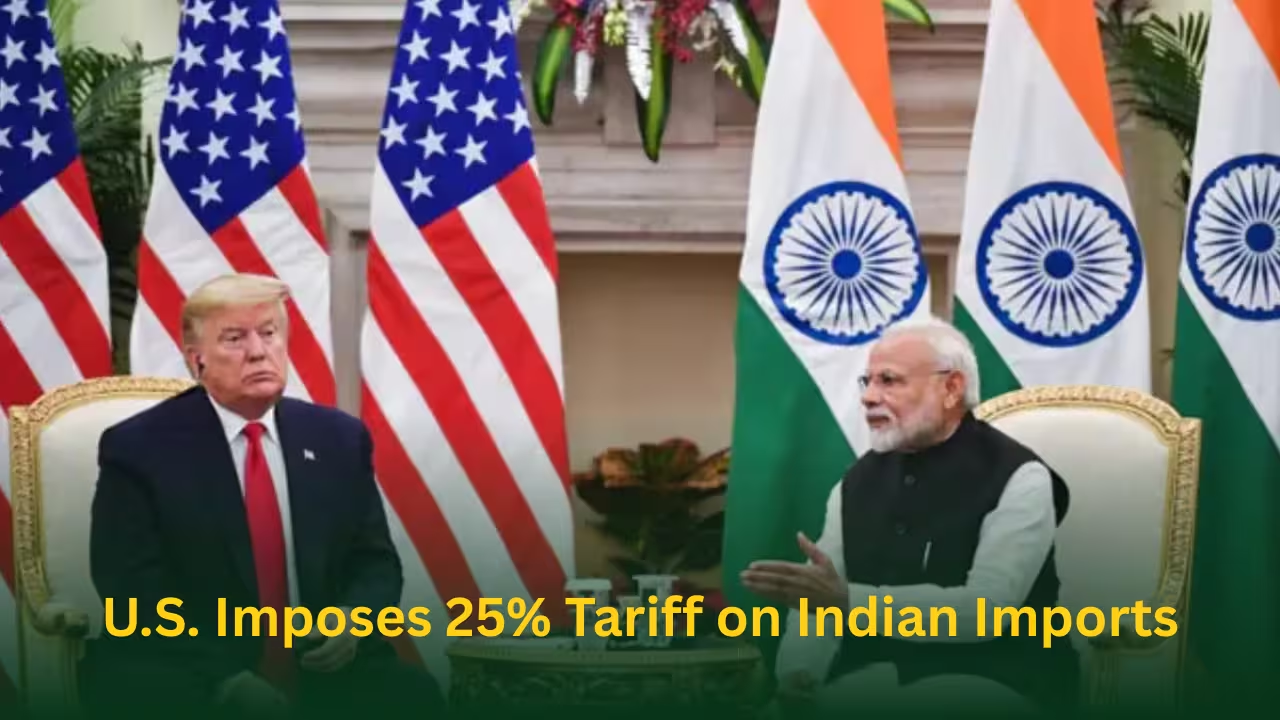U.S. Announces 25% Tariff on Indian Imports: What the Data Shows

Mumbai, July 31, 2025 – The United States has announced a 25% tariff on Indian imports, effective August 1, 2025. This development has raised questions about its potential impact on bilateral trade relations and India's export economy. It also signals possible further measures related to India's international trade engagements.
Economic Impact: Growth Projections Revisited
-
India's Gross Domestic Product (GDP) growth forecast for FY 2025‑26 is expected to decrease by 0.2–0.5 percentage points, potentially bringing growth down to around 6.1%.
-
This reflects a 25–40 basis-point drag on economic output, mainly due to reduced export activity.
Export Exposure: India–U.S. Trade Overview
-
The U.S. contributes nearly 20% of India’s merchandise exports, approximately USD 87 billion (₹7.26 lakh crore).
-
India’s total exports of goods and services in FY 2024‑25 stood at USD 820.9 billion (₹68.45 lakh crore), while imports were USD 915.2 billion (₹76.33 lakh crore), creating a trade deficit of USD 94.3 billion (₹7.88 lakh crore).
-
In June 2025, India’s exports to the U.S. increased by 23% to USD 8.3 billion (₹69,300 crore), while imports from the U.S. declined by 10%.
Sectoral Impact: Key Industries Affected
Pharmaceuticals
-
India exported nearly USD 30 billion (₹2.5 lakh crore) in pharmaceuticals in FY 2023‑24, supplying about 20% of the world’s generic drugs.
-
One-third of India's pharmaceutical exports (approximately USD 9 billion / ₹75,000 crore) go to the U.S.
-
Major companies such as Biocon, Sun Pharma, and Dr. Reddy’s may see earnings impacted by up to 17%.
Textiles and Jewellery
-
Exports to the U.S. from these sectors totaled roughly USD 87.4 billion (₹7.3 lakh crore) in 2024.
-
Key manufacturing regions like Rajasthan employ millions in these industries, which are vulnerable to reduced U.S. demand.
Auto Components and Capital Goods
-
Companies such as Bharat Forge, Sona BLW, and Cummins India export between 5–15% of their products to the U.S.
-
These firms may face margin pressures due to higher tariffs.
Solar Equipment
-
Companies like Waaree Energies rely on U.S. orders for about 20% of their revenue, making them particularly sensitive to tariff-related disruptions.
Market Response: Volatility and Recovery
-
Stock markets initially dropped, with the Sensex and Nifty 50 falling by about 0.6%.
-
The Indian rupee weakened to ₹87.74 per USD, near historical lows.
-
Despite initial losses of over ₹5 lakh crore in market value, recovery followed as markets anticipated further negotiations.
Policy and Industry Reactions
-
The Indian government emphasized its commitment to a balanced and mutually beneficial trade relationship with the U.S.
-
No retaliatory measures have been announced, and trade bodies are encouraging strategic engagement.
-
Exporters from regions such as Surat, Ludhiana, and Tiruppur are exploring diversification toward the European Union (EU) and Association of Southeast Asian Nations (ASEAN) markets.
Outlook: Adapting to Uncertainty
-
U.S.-bound exports account for 2–3% of India’s GDP.
-
The tariffs are likely to affect investment decisions and slow manufacturing momentum.
-
The government projects GDP growth of 6.3–6.8% for FY 2025‑26, but analysts expect figures at the lower end.
Summary Table: Key Metrics
| Metric | Value (FY 2024‑25 / Jun 2025) |
|---|---|
| Total Exports (Goods & Services) | USD 820.9 billion (₹68.45 lakh crore) |
| Exports to the U.S. | USD 87 billion (~20% of total exports / ₹7.26 lakh crore) |
| Projected GDP Growth | 6.3–6.8% |
| Estimated GDP Impact | –0.2% to –0.5% (≈ –25–40 basis points) |
| Pharmaceutical Exports | ~USD 30 billion (₹2.5 lakh crore) |
| Electronics Exports | USD 38.6 billion (₹3.2 lakh crore / 32% YoY growth) |
Conclusion
The U.S. tariff decision introduces economic challenges for several of India’s export-driven sectors. While India’s fundamentals remain resilient, the tariff adds to global uncertainty and could influence investment behavior. Both governments and businesses are evaluating options to mitigate risk and explore new trade opportunities.



 148
148

 The BharatBiz
The BharatBiz
 16
16

